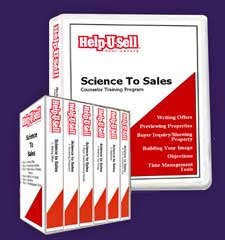Fresh out of college, I became a teacher. I worked with emotionally disturbed adolescents in a psychiatric hospital. Needless to say, it was an easy transition when I started a traditional real estate company and took to recruiting agents! My teaching skills became important again after I sold that office and went to work for Century 21 Corporate. I started as a business consultant but soon was in the classroom, first teaching management courses and then, sales programs. A few years later I found myself at headquarters as VP of Training, responsible for creating every bit of training the company produced and developing a team of trainers spread across the country.
I say all of this to make a point: I know training. I know how to discover the need for it, how to design it for maximum effectiveness, how to coach trainers and how to improve performance with it. That’s why I was floored in 2003 when I encountered Science to Sales. It is the best buyer agent training program I’ve ever seen.
 Science to Sales was created in the early ’90s by Help-U-Sell founder, Don Taylor. It is an activity driven, spaced learning program designed to be coached, not taught. It gets new agents busy immediately and productive quickly, while preserving the broker/trainer’s most precious commodity: time.
Science to Sales was created in the early ’90s by Help-U-Sell founder, Don Taylor. It is an activity driven, spaced learning program designed to be coached, not taught. It gets new agents busy immediately and productive quickly, while preserving the broker/trainer’s most precious commodity: time.
Consider this: the first chapter of Science to Sales has the agent writing 18 sample offers to purchase. 18! By the end of their first week in the business, a Science to Sales trained agent has more experience writing offers than most ordinary agents have in a couple of years!
There is a misconception about Science to Sales. Some think it is a video training program. It’s not. There is a video component, but it was added several years after the original workbook-driven program was created. The six, hour-long videos were created as content for the Help-U-Sell television network and became a valued addition to Science to Sales. Today, the agent meets with their coach at the beginning of the module, then watches the video, completes the activities outlined in the manual, and then meets with the coach again to debrief and prepare for the next module.
In 2004, the program was revamped. Actually, we considered recreating it from the bottom up — and I was given the task of exploring that idea. I struggled. How do you improve on something that’s already this good? I decided that a few minor content tweaks were necessary (the business had changed a little), and that could be easily accomplished in the manuals. But then there were the videos. Oh, they sounded fine. But the clothes and the hairstyles went out of  style a decade ago. I stewed. Would these clunky old videos be an embarrassment? Would the dated look trivialize the program and cause brokers and agents to disregard it? After talking with a dozen great Help-U-Sell brokers I decided to leave them alone. It was clear these guys adored the program just the way it was and considered the opportunity to hear Don Taylor himself on tape to be priceless.
style a decade ago. I stewed. Would these clunky old videos be an embarrassment? Would the dated look trivialize the program and cause brokers and agents to disregard it? After talking with a dozen great Help-U-Sell brokers I decided to leave them alone. It was clear these guys adored the program just the way it was and considered the opportunity to hear Don Taylor himself on tape to be priceless.
Here’s the Good News:
Yesterday, Robert Stevens and I finished uploading the entire program to the Help-U-Sell Download Library. The videos have been digitized and are available for streaming over the internet. The six student chapters have been PDF’d and can be downloaded and printed. Even the coaches guide is there. And it’s all free.
As usual, I see this as an opportunity. Here is your chance to go out this week and recruit an absolute green bean, someone who’s just gotten his or her license and hasn’t got a clue what to do. Then, put them into Science to Sales and see how quickly they become confident, competent and productive! I’d love to hear the results.
(You know how to get to the Download Library, don’t you? Go to helpusell.com, scroll to the bottom of the page and select ‘Help-U-Sell OMS’. If you don’t remember your Log-in and Password, send an email to support@helpusell.com. Go to ‘Marketing and Content’ and you’ll see the Download Library in the drop-down. Expand the item, ‘Help-U-Sell Real Estate,’ and find ‘Science to Sales’ in the list of folders. By the way, you don’t have to stream the videos over the internet. If you’d prefer, they can be downloaded and stored on your computer. Just right click on the individual video link and select ‘Save Target As’. You can use the same procedure to download and save the student and instructor guides. )

 sky was falling! the sky was falling!
sky was falling! the sky was falling!  actually goes on from there.
actually goes on from there.  current real estate markets. Of course, you can’t listen to the ney sayers that surround you. You have to tune them out. But understand that in times like these, when there is a cacophony of negativity and fear, there is also opportunity. These are the times when smart companies grow and gain. These are the times that bring out the Fox in those of us who still have one lurking beneath the surface. My hope is that the Help-U-Sell team gets foxy and we come through this winter with enough fried chicken to last decades!
current real estate markets. Of course, you can’t listen to the ney sayers that surround you. You have to tune them out. But understand that in times like these, when there is a cacophony of negativity and fear, there is also opportunity. These are the times when smart companies grow and gain. These are the times that bring out the Fox in those of us who still have one lurking beneath the surface. My hope is that the Help-U-Sell team gets foxy and we come through this winter with enough fried chicken to last decades!